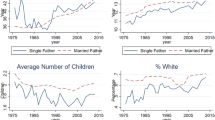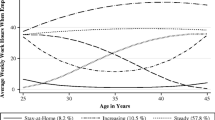Abstract
In this paper we tested three hypotheses: (a) the transition to fatherhood is associated with an increase in work effort; (b) the positive association (if any) between the transition to fatherhood and work effort is greater for fathers who are married at the time of the transition; and (c) the association (if any) is greater for men who make the transition at younger ages. The data are from the National Longitudinal Survey of Youth 1979 Cohort. The transition to fatherhood was associated with an increase in work effort among young unmarried men, but not for married men. Among married men who were on-time fathers, work effort decreased. Among childless men, the marriage transition was associated with increased work effort.

Similar content being viewed by others
Notes
Some feared that an unintended consequence of the policy change would be a decrease in men’s work hours, given one of the major forms that increased stringency took was the attachment of wages. This does not appear to have happened (Freeman and Waldfogelf 1998 ).
In the analyses reported here we included the outliers but top coded them at 240 h. We did several checks to see how robust our results were to the inclusion or exclusion of extreme values and report on these in the section on robustness checks.
There were problems with measuring cohabitation in the NLSY79 and due to these problems we were not able to distinguish unmarried fathers who were cohabiting with the mothers of their children and those who were not.
References
Argys, L. M., & Peters, H. E. (2001). Interactions between unmarried fathers and their children: The role of paternity establishment and child support policies. The American Economic Review, 91, 125–129.
Argys, L. M., Peters, H. E., & Waldman, D. M. (2001). Can the Family Support Act put some life back in deadbeat dads?: An analysis of child-support guidelines, award rates and levels. Journal of Human Resources, 36, 226–252.
Astone, N. M., & Upchurch, D. M. (1994). Forming a family, leaving school early and earning a GED: A racial and cohort comparison. Journal of Marriage and the Family, 56, 759–771.
Bachrach, C., & Sonenstein, F. L. (1998). Male fertility and family formation: Research and data needs on the pathways to fatherhood. In F. I. F. o. C. a. F. Statistics (Ed.), Nurturing fatherhood: Improving data and research on male fertility, family formation and fatherhood (pp. 45–98). Washington D.C.: U.S. Department of Health and Human Services.
Baxter, J., Hewitt, B., & Haynes, M. (2008). Life course transitions and housework: Marriage, parenthood and time on housework. Journal of Marriage and Family, 70, 259–272.
Becker, G. (1981). A treatise on the family. Cambridge, MA: Harvard University Press.
Behrman, J. R., Kohler, H.-P., & Watkins, S. C. (2002). Social networks and changes in contraceptive use over time: Evidence from a longitudinal study in rural Kenya. Demography, 39, 713–738.
Bryk, A., & Raudenbush, S. (1992). Hierachical and linear models: Applications and data analysis methods. London: Sage.
Burchinal, M. R., & Appelbaum, M. I. (1991). Estimating individual developmental functions: Methods and their assumptions. Child Development, 62, 23–43.
Burchinal, M. R., Bailey, D. B., & Snyder, P. (1994). Using growth curve analysis to evaluate child changes in longitudinal investigations. Journal of Early Intervention, 18, 403–423.
Burchinal, M. R., Campbell, F. A., & Bryant, D. M. (1997). Early intervention and mediating processes in cognitive performance of children of low-income African American families. Child Development, 68, 935–954.
Carlson, M., McLanahan, S. S., & England, P. (2004). Union formation and dissolution in fragile families. Demography, 41, 237–261.
Casper, L. M., & Bianchi, S. M. (2002). Continuity and change in the American family. Thousand Oaks, CA: Sage.
Center for Human Resource Research (2008, April 28). National Longitudinal Surveys. http://www.nlsinfo.org/nlsy79/docs/79html/79text/front.htm. Retrieved 1 March 2009.
Cooney, T. M., Pederson, F. A., Indelicato, S., & Palkovitz, R. (1993). Timing of fatherhood: Is “on-time” optimal? Journal of Marriage and the Family, 55, 205–215.
Dribe, M., & Stanfors, M. (2009). Education, work and parenthood: Comparing the experience of young men and women in Sweden. Journal of Family and Economic Issues, 30, 32–42.
Eggebeen, D., & Litcher, D. (1991). Race, family structure, and changing poverty among American children. American Sociological Review, 56, 801–817.
Elder, G. H. (1998). The life course and human development. In R. M. Lerner (Ed.), Volume 1: Theoretical models of human development (5th ed., pp. 939–991). New York: Wiley.
Freeman, R. B., & Waldfogel, J. (1998). Does child support enforcement policy affect male labor supply? In I. Garfinkel, S. S. McLanahan, D. R. Meyer, & J. A. Seltzer (Eds.), Fathers under fire: The revolution in child support enforcement (pp. 94–127). New York: Russell Sage.
Garfinkel, I., Meyer, D. R., & McLanahan, S. S. (1998). A brief history of child support policies in the U.S. In I. Garfinkel, S. S. McLanahan, D. R. Meyer, & J. A. Seltzer (Eds.), Fathers under fire: The revolution in child support enforcement (pp. 14–30). New York: Russell Sage.
Glauber, R. (2008). Race and gender in families and at work: The fatherhood wage premium. Gender and Society, 22, 8–30.
Golden, L. (2008). Limited access: Disparities in flexible work schedules and work-at-home. Journal of Family and Economic Issues, 29, 86–109.
Gupta, N. D., Smith, N., & Stratton, L. S. (2007). Is marriage poisonous? Are relationships taxing? An analysis of the male marital wage differential in Denmark. Southern Economic Journal, 74, 412–433.
Hall, S., & MacDermid, S. (2009). A typology of dual earner marriages based on work and family arrangements. Journal of Family and Economic Issues, 30, 215–225.
Hao, L., Astone, N. M., & Cherlin, A. J. (2007). Effects of child support and welfare policies on nonmarital teenage childbearing and motherhood. Population and Policy Review, 26, 235–257.
Herbst, C., & Barnow, B. (2008). Close to home: A simultaneous equations model of the relationship between child care accessibility and female labor force participation. Journal of Family and Economic Issues, 29, 128–151.
Hogan, D. P., & Astone, N. M. (1986). The transition to adulthood. Annual Review of Sociology, 12, 109–130.
Korenman, S., & Neumark, D. (1991). Does marriage really make men more productive? Journal of Human Resources, 26, 282–307.
Lin, T.-F., & Chen, J. (2006). Custodial fathers: Do they work more or fewer hours? Journal of Family and Economic Issues, 27, 513–522.
Lundberg, S., & Rose, E. (2000). Parenthood and the earnings of men and women. Labour Economics, 7, 689–710.
Lundberg, S., & Rose, E. (2002). The effects of sons and daughters on men’s labor supply and wages. The Review of Economics and Statistics, 84, 251–268.
Mammen, S., Lass, D., & Seiling, S. (2009). Labor force supply decisions of rural low-income mothers. Journal of Family and Economic Issues, 30, 67–79.
Martin, G., & Kats, V. (2003). Families and work in transition in 12 countries, 1980–2001. Monthly Labor Review, 126, 3–31.
Martinez, G. M., & Day, J. C. (1999). School enrollment: Social and economic characteristics of students. Current Population Reports, Series P-20(516).
Maume, D. J. (2006). Gender differences in restricting work efforts because of family responsibilities. Journal of Marriage and the Family, 68, 859–869.
McDonald, J. F., & Moffitt, R. A. (1980). The uses of tobit models. The Review of Economics and Statistics, 62, 318–321.
Molina, J., & Montuenga, V. (2009). The motherhood wage penalty in Spain. Journal of Family and Economic Issues, 30, 237–251.
Monna, B., & Gauthier, A. (2008). A review of the literature on the social and economic determinants of parental time. Journal of Family and Economic Issues, 29, 634–653.
Murasko, J. (2008). Married women’s labor supply and spousal health insurance coverage in the United States: Results from panel data. Journal of Family and Economic Issues, 29, 391–406.
National Longitudinal Surveys (2008, April 28). Bureau of Labor Statistics. http://www.bls.gov/nls. Retrieved 1 March 2009.
Nock, S. L. (1998). Marriage in men’s lives. Cambridge, MA: Oxford University Press.
Olsen, G. I., & Xiao, J. J. (1996). Effects of relative advantage on time use in farm families. Journal of Family and Economic Issues, 17, 351–363.
Pagani, L., & Marenzi, A. (2008). The labor market participation of Sandwich Generation Italian women. Journal of Family and Economic Issues, 29, 427–444.
Radey, M. (2008). The influence of social supports on employment for Hispanic, Black and White unmarried mothers. Journal of Family and Economic Issues, 29, 445–460.
Rendall, M. S., Clarke, L., Peters, H. E., Ranjit, N., & Verropoulou, G. (1999). Incomplete reporting of men’s fertility in the United States and Britain: A research note. Demography, 36, 135–144.
Ribar, D. C. (2004). What do social scientists know about the benefits of marriage? A review of quantitative methodologies. IZA discussion paper series. Bonn, Germany: Institute for the Study of Labor.
Roy, K. M. (2005). Transitions on the margins of work and family life for low-income African American fathers. Journal of Family and Economic Issues, 26, 77–100.
Sanchez, L., & Thomson, E. (1997). Becoming mothers and fathers: Parenthood, gender and the division of labor. Gender and Society, 11, 747–772.
Shanahan, M. J. (2000). Pathways to adulthood in changing societies: Variability and mechanisms in life course perspective. Annual Review of Sociology, 26, 667–692.
Tobin, J. (1958). Estimation of relationships for limited dependent variables. Econometrica, 26(1), 24–36.
Weagley, R. O., Chan, M.-L., & Yan, J. (2007). Married couples’ time allocation decisions and marital stability. Journal of Family and Economic Issues, 28, 507–525.
Acknowledgments
This research was supported by a grant from the National Institutes of Health (P01 HD045610) to Freya Sonenstein and from Cooperative State Research, Education and Extension Service, U.S. Department of Agriculture, under Project No. ILLU-45-0366 to Joseph H. Pleck.




